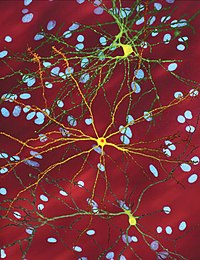
Photo from wikipedia
As the leading cause of cancer-related deaths worldwide, early detection and diagnosis are crucial to reduce the mortality of lung cancer. To date, the diagnosis of the peripheral pulmonary lesions… Click to show full abstract
As the leading cause of cancer-related deaths worldwide, early detection and diagnosis are crucial to reduce the mortality of lung cancer. To date, the diagnosis of the peripheral pulmonary lesions (PPLs) remains a major unmet clinical need. The urgency of diagnosing PPLs has driven a series of development of the advanced bronchoscopy-guided techniques in the past decades, such as radial probe-endobronchial ultrasonography (RP-EBUS), virtual bronchoscopy navigation (VBN), electromagnetic navigation bronchoscopy (ENB), bronchoscopic transparenchymal nodule access (BTPNA), and robotic-assisted bronchoscopy. However, these techniques also have their own limitations. In this review, we would like to introduce the development of diagnostic techniques for PPLs, with a special focus on biopsy approaches and advanced guided bronchoscopy techniques by discussing their advantages, limitations, and future prospects.
Journal Title: Therapeutic Advances in Chronic Disease
Year Published: 2023
Link to full text (if available)
Share on Social Media: Sign Up to like & get
recommendations!